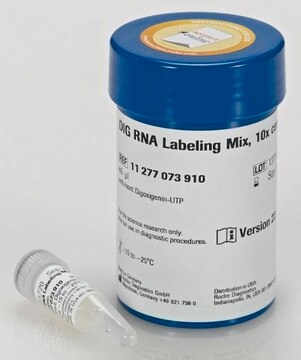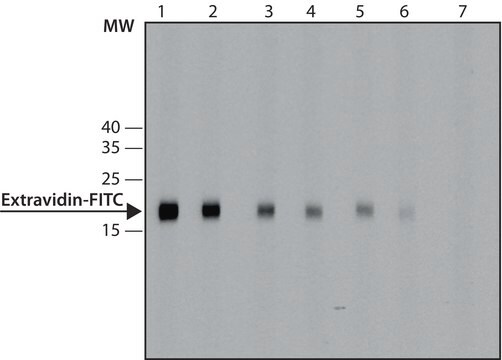11426346910
Roche
Anti-Fluorescein-POD, Fab fragments
from sheep
Sinónimos:
antibody
About This Item
Productos recomendados
biological source
sheep
Quality Level
conjugate
peroxidase conjugate
antibody form
purified immunoglobulin
antibody product type
primary antibodies
clone
polyclonal
form
lyophilized (stabilized)
packaging
pkg of 150 U
manufacturer/tradename
Roche
storage temp.
2-8°C
1 of 4
Este artículo | 11207741910 | 11207733910 | 11093274910 |
|---|---|---|---|
| clone polyclonal | clone polyclonal | clone polyclonal | clone polyclonal |
| biological source sheep | biological source sheep | biological source sheep | biological source sheep |
| antibody form purified immunoglobulin | antibody form purified immunoglobulin | antibody form F(ab′)2 fragment of affinity isolated antibody | antibody form purified immunoglobulin |
| storage temp. 2-8°C | storage temp. 2-8°C | storage temp. 2-8°C | storage temp. 2-8°C |
| form lyophilized (stabilized) | form lyophilized | form lyophilized (clear, brown solution after reconstitution) | form solution |
General description
Specificity
Application
Preparation Note
- Dot blot: 150 mU/ml
- ELISA: 50 to 150 mU/ml
- Immunohistocytochemistry: 250 to 500 mU/ml
- In situ hybridization: 1.5 to 7.5 U/ml
- Southern blot: 150 mU/ml
- Western blot: 500 to 1000 mU/ml
Working solution: 100 mM Tris-HCl, 150 mM NaCl, pH 7.5. If necessary 1% Blocking reagent (w/v), dry milk powder, 1 to 5% heat inactivated fetal calf serum (v/v) or sheep normal serum can be used for reduction of unspecific binding.
Reconstitution
Other Notes
¿No encuentra el producto adecuado?
Pruebe nuestro Herramienta de selección de productos.
signalword
Warning
hcodes
Hazard Classifications
Skin Sens. 1
Storage Class
12 - Non Combustible Liquids
wgk_germany
WGK 1
flash_point_f
does not flash
flash_point_c
does not flash
Elija entre una de las versiones más recientes:
¿Ya tiene este producto?
Encuentre la documentación para los productos que ha comprado recientemente en la Biblioteca de documentos.
Los clientes también vieron
Nuestro equipo de científicos tiene experiencia en todas las áreas de investigación: Ciencias de la vida, Ciencia de los materiales, Síntesis química, Cromatografía, Analítica y muchas otras.
Póngase en contacto con el Servicio técnico






